There are many types of flying insects, and some of them can be pests that bite and sting. Meanwhile, others can ruin structures.
So, what are these flying insects? The most common types of flying insects are house flies, fruit flies, and flying ants. These insects are all nuisances, and some of them can transmit various diseases. In addition, paper wasps, hornets, honey bees, and carpenter bees can sting, so it’s best to identify and treat these insects accordingly.
Most flying insects possess two sets of wings that are connected to their thorax. They typically go through a life cycle with four stages—egg, larva, pupa, and adult.
How Many Species of Flying Insects Are There?
According to research, there are 71,600 identified flying insects species. The largest species in the US fall into the four orders, which are:
- Coleoptera (beetles)—23,700
- Diptera (flies)—19,600
- Hymenoptera (ants, bees, wasps)—17,500
- Lepidoptera (moths and butterflies)—11,500
How to Identify Flying Insects?
Flying insects can be both found indoors and outdoors. The most typical flying insects spotted at home are mosquitoes, flies, and cockroaches, which are disease carriers.
In addition, flying insects like termites can destroy your furniture and structure, and moths can damage your clothing. Meanwhile, beetles can ruin your woolen carpets and leather goods.
There are at least 25 groups of flying insects, according to entomologists, and they are:
- Order Hymenoptera: Flying ants, bees, wasps, sawflies
- Order Odonata: Dragonflies, damselflies
- Order Siphonaptera: Fleas
- Order Diptera: Flies
- Order Phasmida: Stick bugs, leaf flying insects
- Order Isoptera: Winged termites
- Order Hemiptera: Cicadas, aphids, hoppers, water bugs
- Order Orthoptera: Insects–grasshoppers, crickets
- Order Dictyoptera: Cockroaches, mantids
- Order Lepidoptera: Butterflies, moths
- Order Coleoptera: Beetles
Lifecycle of Flying Animals
Most flying animals undergo a stage called metamorphosis. This is a stage where insects change their appearance and build.
There are two metamorphosis types—complete and incomplete metamorphosis. Cockroaches, crickets, and dragonflies are some of the insects that undergo incomplete metamorphosis.
Meanwhile, butterflies, flies, beetles, and bees are among the flying insects that go through complete metamorphosis. Complete metamorphosis is a term linked with the growing insect groups, wherein the hatched egg produces a worm-like form, such as:
- Scarabaeiform—grublike form
- Campodeiform—elongated and flattened in form
- Eruciform—caterpillar-like form
- Elateriform—wireworm-like appearance
- Vermiform—maggot-like form
The Body Structure of Flying Insects
Males and females of flying insects differ significantly in body form. The body of these insects can be divided into three sections:
- Head – The head part comprises two sensitive antennae, eyes and mouthparts.
- Thorax (three-segmented) – This is typically three pairs of jointed legs with two to four wings.
- Segmented abdomen – This is composed of reproductive, digestive, and excretory organs. The three abdominal units are interconnected but are distinct from each other.
Flying insects typically have one to three simple eyes located in the head part, aside from the pair of evolved compound eyes they have. Nonetheless, these eyelike markings can also be seen on their wings like butterflies.
Flying Insects | Identification
Since there are many species of flying insects, it’s best to identify them accordingly. Below are some of the flying insect species and their characteristics:
House Flies
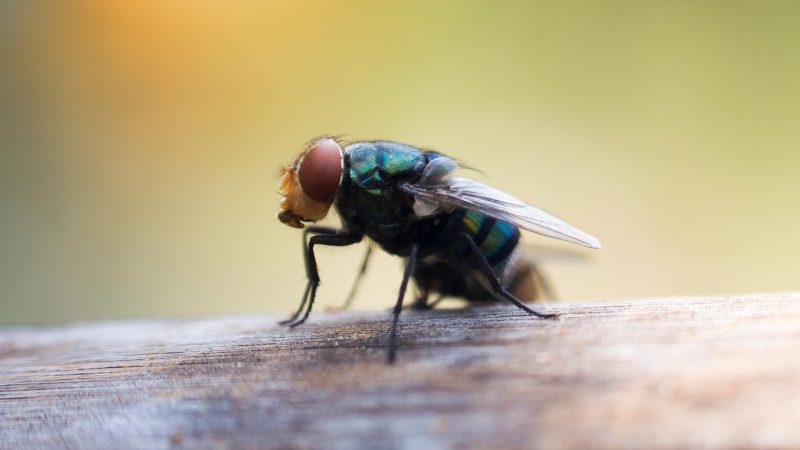
- Habitat: Decaying matter, walls, ceilings, garbage, feces, and human food.
- Distinct characteristics: They have reddish eyes, sponging mouthparts, four narrow black stripes located in the thorax, and slightly hairy bodies.
- Threat: They can transmit diseases, such as shigellosis, typhoid fever, E. Coli, and cholera.
- Treatment: Natural trap bait, vinegar and dish soap spray, cayenne pepper spray, Pyrethrin-based insecticide, light trap, sticky trap, or call pest control professionals.
House flies are the most common type of flies found in homes. Their color ranges from gray to black, having four dark stripes on their thorax.
They have slightly hairy bodies, a pair of wings, and reddish eyes. Female house flies are a bit larger than male house flies, about 5 to 7 mm long.
In addition, female eye space is twice as wide as males. House flies undergo a complete metamorphosis that involves egg/larva or maggot/pupal and adult stages. Typically, common house flies can last up to 28 days.
Related: House Fly Control: How To Get Rid of House Flies?
Mosquitoes
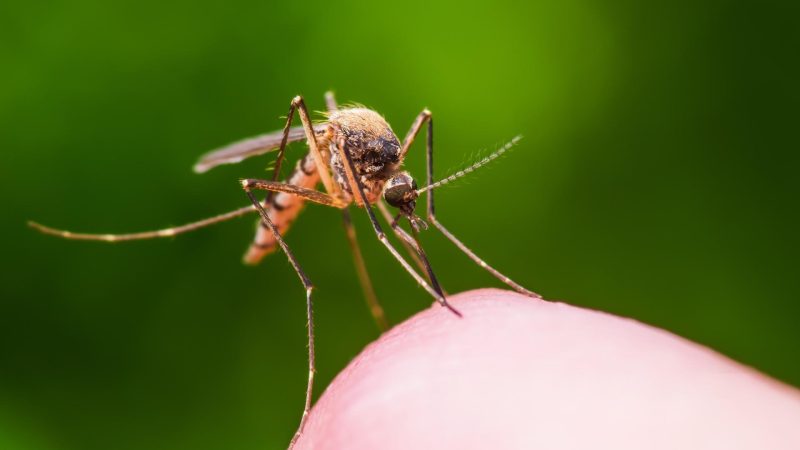
- Habitat: Forests, marshes, tall grasses, ponds, and stored uncovered water.
- Distinct characteristics: They have long and thin bodies, long legs, sharp beak-like sucking mouths, and hairy antennae.
- Threat: They can cause malaria, dengue fever, yellow fever or can cause irritation and swelling.
- Treatment: To get rid of mosquitoes, you may use mosquito traps, essential oils, mosquito netting, and insecticide.
One of the most dangerous flying insect species on the planet is mosquitoes. These mosquitoes cause skin irritation or the transmission of severe diseases, such as Zika, dengue, and malaria.
Mosquitos have three pairs of long legs and thin bodies. You can find scales along their wings’ veins and sharp, beak-like mouthparts named proboscis.
Furthermore, they have hairy antennae that sets them apart from other flying insect species. They’re about 0.15–0.4 inches long and can live up to two to three weeks.
Related: How to Get Rid of Mosquitoes Indoors? | 11 Effective Ways to Know
Fruit Flies
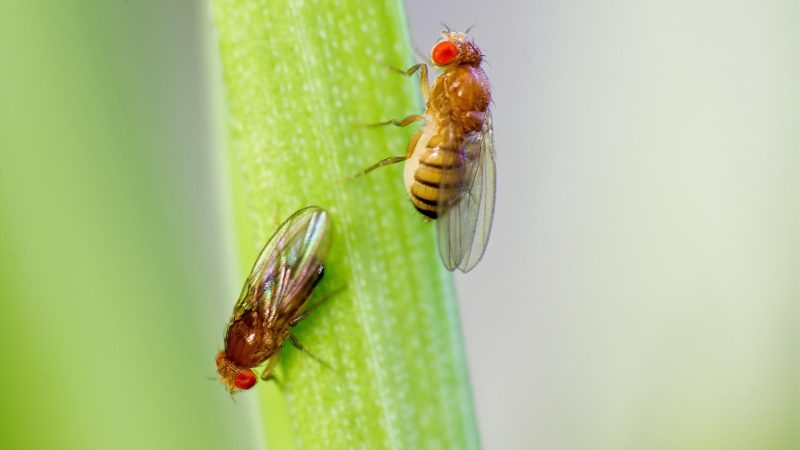
- Habitat: These insects can be found in homes, grocery stores, restaurants, and in any place with rotten or fermented food.
- Distinct characteristics: They are yellow to brownish in color, possess antennae with feathery bristles, and have thickened margin wings.
- Threat: They contaminate food and clean areas with disease-causing diseases.
- Treatment: Look for breeding sites and clean up those areas. Throw garbage regularly and clean up your drain. Make traps, such as wine traps, apple cider vinegar traps, rotten fruit traps, yeast traps, and use bug spray.
Fruit flies are among the flying insects commonly found flying around in areas with carcasses, rotten fruits, and meats. They’re also found around garbage cans that aren’t properly covered.
Fruit flies are minuscule, oval insects, which are approximately 1/8 inch. They typically have red eyes, though some of them have dark-colored eyes.
In addition, they have a black abdomen and gray underbelly. But, overall, fruit flies have a tan look and can live up to 40 to 50 days.
Related: Where Do Fruit Flies Come From? | Information and Facts
Flying Ants
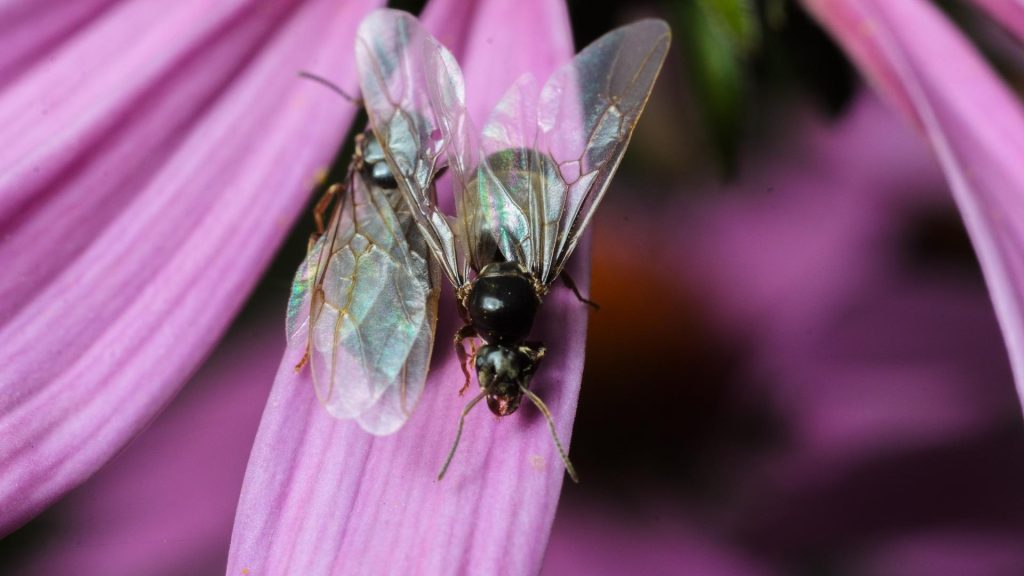
- Habitat: Flower beds, lawns, and beneath paving slabs or stones.
- Distinct characteristics: They have bent antennae, unequal lengths of wings, and a pinched waist.
- Threat: They can damage structures in the long run.
- Treatment: Boric acid, dish soap and peppermint oil solution (spray), sticky tape traps, vacuum, and insecticide spray.
Flying ants or alates are normal ants that are sexually mature. They’re the colony’s reproductives produced by the queen ant and fed by the worker ants.
The primary goal of these reproductives is to set up a new colony. Flying ants have bent antennae, unequal lengths of wings, and a pinched waist. Moreover. these ants can typically measure up to 7 to 12 mm in length, while males can reach up to 18 mm in length.
Related: How to Get Rid of Flying Ants: A Complete Guide
Flying Termites
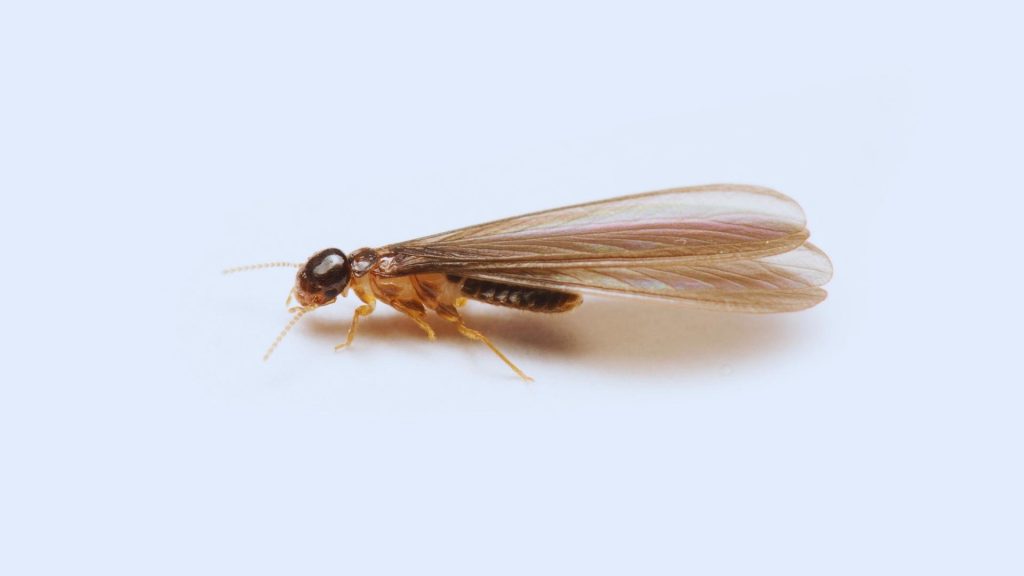
- Habitat: Cracks in walls and foundation, wet soil, and underground.
- Distinct characteristics: They have a straight and equal length of antennae, two sets of wings, a long, two-segmented abdomen, and a straight waist.
- Threat: They can damage structures.
- Treatment: You may use vinegar, borates, and orange oil as sprays to deter and eliminate flying termites. Also, you can use insecticides or call your local pest control expert to handle the problem.
Flying termites are the reproductive stage of termites. They’re also known as alates that emerge from existing colonies to mate and build new nests somewhere.
The flying termites are in the alates stage and have the same look as flying ants. However, you can spot their differences by looking at their wings, abdomen, and antennae.
As opposed to flying ants, these termites have a straight and equal length of antennae and two sets of wings. Moreover, their body has two segments along with a straight abdomen.
Furthermore, flying termites are approximately 3/8 of an inch. Luckily, these termites can last only for 30 to 40 minutes if they can’t find soil and die from dehydration after a few hours.
Paper Wasps

- Habitat: Tree branches, under eaves, attic rafters, and porch ceilings
- Distinct characteristics: They have jet black or brown body with paired segmented spots and narrow yellow bands. Also, they possess six legs.
- Threat: They can cause wood damage and can be a nuisance to your property.
- Treatment: You may use insecticide spray, pesticide spray, barrier treatment, or call a pest control service.
Paper wasps are stinging insects with a striking appearance. They’re approximately 16 mm to 20 mm long with two wings and orange antennae and tarsi.
Paper wasps have a similar body as yellow jackets but a much slimmer waist. Worker wasps can live up to around 3 to 4 months, while the queen wasp can live up to 10 to 12 months.
Hornets
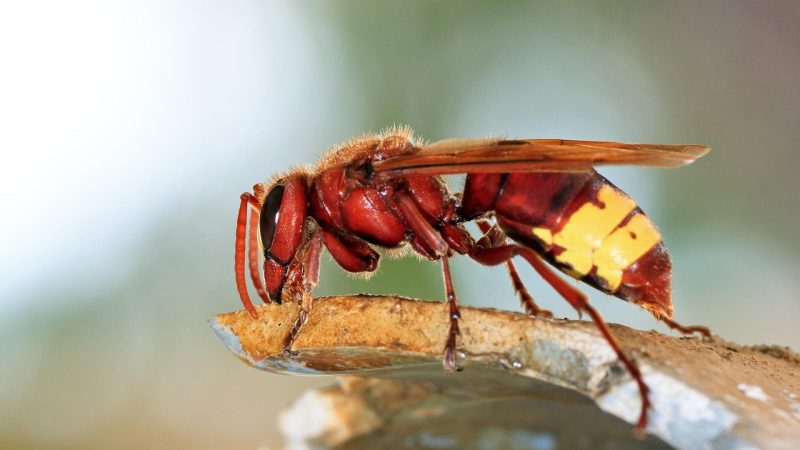
- Habitat: Meadow, orchards, woodlands, playgrounds, and urban and suburban settings.
- Distinct characteristics: They have sturdy physiques, light yellow or black in white in color, soft and even body textures. Also, they have 13 segmented antennae and two pairs of uneven wings attached to their thorax.
- Threat: They can pose health risks to humans.
- Treatment: If they sting you, put a cold compress on the sting area, or take an antihistamine. To get rid of these insects, spray with insecticides, but make sure you’re wearing protective gear. If you’re unsure of how to address the issue, make sure to call your local pest control expert.
Hornets are the largest eusocial wasps. They have a similar appearance as yellow jackets and can reach up to 2.2 inches in length. Their bodies have soft and even textures.
Furthermore, worker hornets can live for 12 to 22 days, while the queen can last up to one year.
Mud Daubers
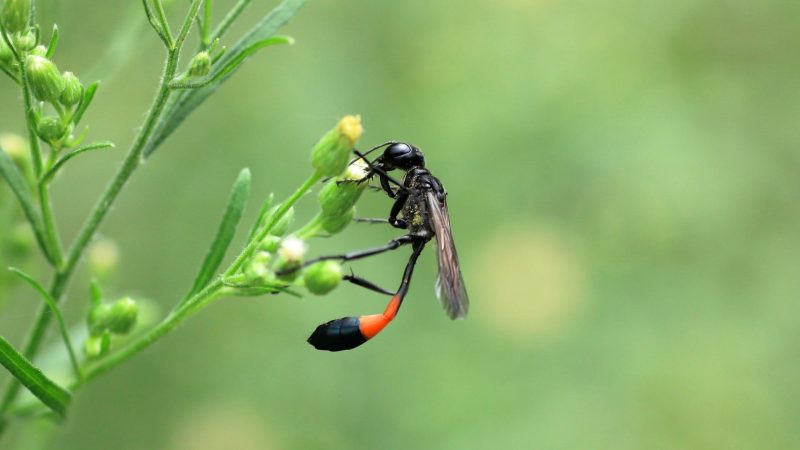
- Habitat: Porch ceilings, under eaves, and sheds and barns
- Distinct characteristics: They have faded black to black color.
- Threat: They can cause damage to your home, discolor siding and make a mess on your property.
- Treatment: Use wasps trap like jam and hang it to your trees or put it in areas where these insects are frequent. You may also use essential oil sprays, such as citrus oil and peppermint oil. You may also use vinegar or dishwashing soap and spray it to the affected area.
Mud daubers are wasps that construct their nests from mud. They’re about 3/4 to 1 inch in length and have a faded black to black color.
In addition, they have bright yellow to iridescent blue-black markings, narrow waist, and can live up to one year.
Related: Mud Dauber Sting and Treatment | A Complete Guide
Honey Bees
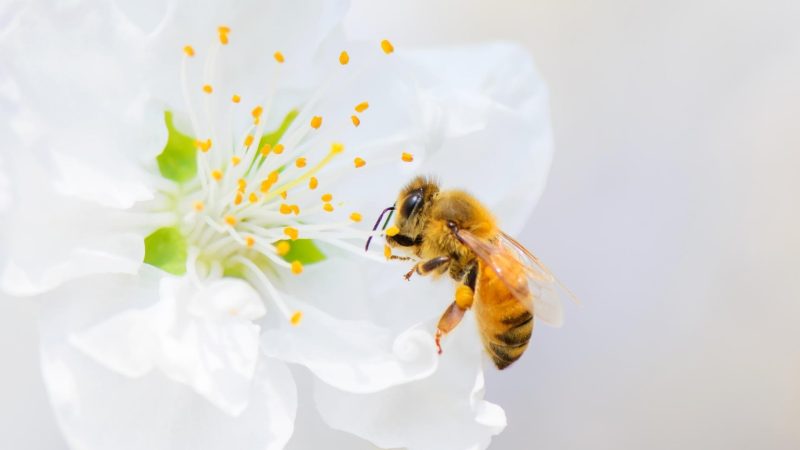
- Habitat: Gardens, woodlands, orchards, meadows, and areas with many flowering plants.
- Distinct characteristics: They have stinger legs, movable segmented feeler antenna, and three thorax segments. Moreover, they have six visible segments of the abdomen.
- Threat: They can attack and sting you, causing allergic reactions.
- Treatment: Apply an ice compress to the sting site. Use hydrocortisone cream or calamine lotion to rescue itching and redness. You may also take anti-inflammatories to lessen pain and swelling.
Honey bees are stinging insects that feed on nectar and pollen. They’re typically oval in shape and golden-yellow in color with brown bands.
However, their colors vary, depending on their species. They mostly have black bodies, but some of these bees have differing striations from dark to light.
Moreover, they are about 15 mm long. They can last up to 15 to 30 days for worker bees and 1 to 2 years for queen honey bees.
Carpenter Bees
- Habitat: Eaves, rafters, fascia boards, siding, wooden shake roofs, decks, and outdoor furniture.
- Distinct characteristics: They have large, black bees that have a hairless, shiny abdomen.
- Threat: They cause wood damage to structures by making tunnels into the wood, creating their nesting chambers.
- Treatment: You can use pesticides, Diatomaceous earth, loud music, and citrus spray. Also, you may call for a pest control service to do the work for you.
Carpenter bees are large, black bees that hover around your home. They resemble bumblebees but with hairless, shiny abdomens.
Furthermore, the adult has a length of 12.5 to 25 mm and can live up to 3 years. The male bees possess a yellow face with a white dot on their heads. Meanwhile, the female carpenter bees’ face is black.
Related: Carpenter Bee Control: How To Get Rid of Carpenter Bees?
How Will You Prevent the Entry of Insects?
To prevent the entry of these insects, consider to do the following:
- Eliminate their shelter, food, and water sources.
- Never let water gather in any areas of your home.
- Seal the pests’ entry points.
- Inspect and repair window screens.
- Avoid presenting a hiding place for these pests by cleaning and organizing your home regularly.
What Is Used to Trap Flying Insects?
There are various ways to trap flying insects, and some of them are:
Flight Interception Traps
These traps are net-like structures that block flying insects. This comprises a vertical sheet or wall, routing insects down into the collection containers.
Sticky Traps
Another way to trap flying insects is through sticky traps. These traps could be enclosed, or flat panels and are widely used in monitoring indoor and agricultural pests.
- Based on physical principles: The Sticky Pest Trap is a bright...
- Long-lasting And Durable: UV-resistant and waterproof. Resistant...
- Thoughtful Design: Reserved glue-free section so that it won't...
- Eco-friendly And Natural Control: Harmless and odorless,...
- Multiple Scenarios Use: Specially designed to catch flying plant...
Light Traps
Light traps are known to attract insects. This method works by attracting the pests to the light with attached glue traps, getting them stuck.
- Triple trapping power: a UV light, powerful fan, and sticky glue...
- Contact-free disposal: No zapper needed! Glue boards allow for...
- No more ugly traps: Subtle and sleek, Katchy will fit seamlessly...
- Multiple settings to fit your needs: includes two fan settings to...
- Works for multiple insect types: Is effective in killing fruit...
What Is the Best Indoor Flying Insect Killer?
Since many indoor flying insect killer products are out in the market, we have compiled some of the best products you can use, and they are:
Picaridin Insect Repellent
This insect repellent is effective in killing the disease-carrying mosquitoes, along with ticks, gnats, and flies. Just spray this around your place or directly to the flying insects you see.
Pros:
- Works best for mosquitos and ticks
- Minimum odor
Cons:
- Smaller container
- Don’t work for wasps or hornets
- Reapplication needed
- Non-greasy, fragrance free, odorless; dries quickly and won't...
- Safe for use on the whole family, long-lasting insect and tick...
- Fragrance-free topical insect repellent with 20% Picaridin —...
- Very comfortable to wear on your skin, it's ideal for all your...
- Top rated bug repellent by WireCutter/New York Times (May, 2020);...
Ortho Home Defense Spray
This defense spray is highly effective against wasps and hornets. Its spray can reach up to 20 feet and come in a 16-ounce container.
Pros:
- Works best for wasps and hornets
- Can reach up to 20 feet
- 16 oz container
Cons:
- Not effective to mosquitoes
- Can harm plants if used for long-term
- Keep your home clear of wasps with Ortho Home Defense Hornet &...
- This wasp spray reaches nests up to 20 feet above ground and...
- Use this wasp killer outdoors under eaves, near window frames,...
- To kill wasps, yellow jackets, mud daubers, and hornets, spray...
- Ortho Home Defense Hornet & Wasp Killer7 may also be used to...
Summary
There are many types of flying insects. Although not all of them can cause severe harm, some of them can pose threats to your home and family’s health.
Thus, it’s best to identify them to apply the right solution. You may see the flying insects’ identification in this article and try the given methods to eliminate them.
List of Sources
Numbers of Insects (Species and Individuals). (1996). Smithsonian.
House Fly. KwaZulu-Natal Department of Health.
Potter, M. F. (1994). Fruit Flies. University of Kentucky.
Mud Daubers. Texas A&M AgriLife Extension.
- How to Get Rid of Copperheads | Practical Guide - August 27, 2023
- How to Get Rid of Corn Snakes | What Makes Them Aggressive? - August 27, 2023
- How to Get Rid of Alligators | Safety Measures and Removal Methods - July 16, 2023




